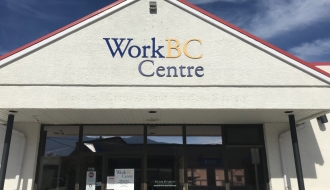Career Overview
Secondary school teachers work with students from Grades 8 to 12. They teach academic, technical, career preparation and elective subjects.
This group includes department heads.
Job Titles
Duties
In general, secondary school teachers:
- Prepare and present course material to students following an approved curriculum
- Include Indigenous perspectives in lessons
- Use an organized plan of lectures, discussions, online and in-class assignments, and audio-visual presentations
- Include laboratory work, workshop instruction and field studies, as appropriate
- Assign and mark assignments, homework and tests
- Check students’ progress and determine their individual needs
- Discuss students’ needs with parents and, as needed, with school officials
- Develop and follow special programs for students, such as Individual Education Plans (IEPs), as needed
- Attend staff meetings, district meetings, educational conferences and teacher-training workshops
- Build respectful, caring relationships with students
They may also:
- Help students choose courses, prepare for a career, and deal with personal problems
- Supervise student teachers and mentor new teachers
- Teach distance or online courses
- Prepare students for provincial exams
Most secondary school teachers specialize in a subject area. They may focus on mathematics, social studies, English, French, sciences, physical education, career preparation, or English language learning (ELL) instruction. Some teach elective subjects such as music, drama, art or photography. Others teach job-related skills such as carpentry, drafting, auto mechanics, cooking or hairdressing. Still others offer special education to students with special needs.
Earnings
Earnings is income that workers receive in exchange for their labour. Depending on the type of employment, earnings can be in the form of wages (hourly), salaries (fixed monthly or annual) or self-employed earnings.
Work Environment
# Workers Employed
18,380% Employed Full Time
82%Secondary school teachers work in public and private secondary schools. They may also work for technical institutes, vocational schools or language schools. They teach in classrooms, labs, libraries, workshops, gymnasiums or cafeterias. Some classes take place in the community or outdoors.
Most teachers work a 10-month school year, with two months off in July and August. They also have holidays over winter and spring break.
Teachers often spend time outside of regular school hours preparing lessons, grading assignments, coaching sports teams, hosting student clubs and doing administrative work. Total number of hours vary from teacher to teacher.
Teaching can be stressful, and working with youth can be challenging. Long periods of standing and speaking can lead to back and voice problems. Science labs and shop classes can also pose danger.
Secondary school teachers use technology to develop and give lessons, receive assignments, take attendance, grade work and communicate with students and parents.
Career Pathways
Some new graduates secure teaching contracts right away. But many begin their careers as full- or part-time teachers teaching on call (TTOCs). TTOCs fill in for teachers who are absent, whether for a few hours, a few days, or while taking maternity leave or sabbatical.
New teachers usually teach junior-level courses. Those with experience often take on more senior courses. They may also have other responsibilities, including acting as department heads or program co-ordinators, or leading staff or district committees.
Teachers with experience and more education may move on to positions such as school counsellors or teacher-librarians. Some may advance into roles as education consultants, vice-principals or principals. Or they may become superintendents, specialists or senior managers at the school district level.
Related Careers
Occupational Interests
It’s important to understand what kinds of occupations align with your interests.
For more about occupational interests visit Skills for the Future Workforce > Characteristics.
Here are the top occupational interest(s) for this career profile:
Education, Training and Skills
To teach academic subjects, secondary school teachers must have a bachelor’s degree in education. Most teachers earn this after getting a bachelor’s degree in the arts or sciences. Teachers must also have a provincial teaching certificate.
Secondary school teachers must be familiar with technology such as Microsoft Teams, G Suite and Google Classroom. Experience working with youth, such as coaching or community mentoring, is also very helpful.
Other requirements vary depending on the teacher’s area of focus. These include:
- Specialized training or experience in their subject area
- Special qualifications for school counsellors and teacher-librarians
- Additional training for those teaching special education (for students with special needs), inclusive education (for special-needs students in regular classes) or English language learning (ELL) (for students whose first language is not English)
- ELL experience for teachers working in school districts with a high number of ELL students
Education programs in B.C.
The following program areas are related to this occupation:
- Elementary/Secondary Teaching Related

Skills
Every job calls for a certain set of skills. Knowing those skills is the first step in finding a good career fit.
Here, you will find the 10 most relevant workplace skills. Some are more important to achieving success in a certain career than others. These skills may come naturally to you or you may need to gain them through education, training and experience.
See the list of work-related skills below, ranked in order of importance for this career. Check out the list and see if this career matches your skills—take that first step!
Teaching others how to do something.
Talking to others to share information effectively.
Choosing and using training, instructional methods and procedures appropriate for the situation when learning or teaching new things.
Giving full attention to what other people are saying, taking time to understand the points being made, asking questions as appropriate, and not interrupting at inappropriate times.
Understanding written sentences and paragraphs in work-related documents.
Keeping track of and assessing your performance, other individuals, or organizations to make improvements or take corrective action.
Communicating effectively in writing as appropriate for the needs of the audience.
Being aware of others’ reactions and understanding why they react as they do.
Using logic and reasoning to identify the strengths and weaknesses of alternative solutions, conclusions or approaches to problems.
Adjusting actions in relation to others' actions.
Labour Market Statistics
Discover data, facts and information that have been gathered and analyzed. Learn about the characteristics of the economy and labour market in B.C.
Employment
Find out about employment types and trends by region and industry.
Employment
18,380Employment by Region







| Region | Employment | % Employment of this Occupation |
|---|---|---|
| Cariboo | 550 | 3.0% |
| Kootenay | 545 | 3.0% |
| Mainland/Southwest | 11,570 | 62.9% |
| North Coast and Nechako | 445 | 2.4% |
| Northeast | 170 | 0.9% |
| Thompson-Okanagan | 2,035 | 11.1% |
| Vancouver Island/Coast | 3,065 | 16.7% |
Labour Market Outlook
The B.C. Labour Market Outlook is a 10-year forecast of the expected supply and demand for labour in the province. It’s usually updated every year. The purpose is to provide British Columbians with the knowledge to make informed decisions on careers, skills training, education and hiring.
Forecasted Job Openings (2024-2034)
7,820Forecasted Job Openings
Forecasted Employment Growth Rate
Composition of Job Openings
Job Openings by Region (2024-2034)







| Region | Job Openings | Avg. Annual Employment Growth |
|---|---|---|
| Cariboo | 50 | -1.5% |
| Kootenay | 180 | 0.1% |
| Mainland/Southwest | 5,350 | 1.6% |
| North Coast and Nechako | 110 | -0.1% |
| Northeast | 40 | -0.1% |
| Thompson-Okanagan | 770 | 0.6% |
| Vancouver Island/Coast | 1,320 | 0.9% |
Industry Highlights
Learn about the opportunities in B.C.'s major industries, including employment trends, earning potential, locations of work and more.
Forecasted Job Openings by Industry
| Industry | Job Openings (2024-2034) |
|---|---|
| Educational Services | 7,760 |
| Public Administration | 30 |
| Repair, Personal and Non-Profit Services | 10 |
| Health Care and Social Assistance | 10 |
Insights from Industry
Teaching duties are evolving. More online resources are being used, and more focus is being placed on personalized learning and on developing students’ intellectual, personal and social skills.
With many teachers retiring and classroom size decreasing, B.C. has a shortage of trained teachers. Demand is especially high in northern B.C. and other rural areas.
Teachers who specialize in advanced math, physics, chemistry, French and French immersion are in demand throughout the province. Those who teach business education, technology education, home economics, special needs and English language learning (ELL) also have good job prospects. And the increase in career training programs means new openings for teachers of business office management, agricultural technology, food services, restaurant and hotel service and management, applied physics, environmental studies, construction, drafting, mechanics, textile and clothing production, health and social services.
Resources
-
B.C. Ministry of Educationwww.gov.bc.ca/bced
-
British Columbia Public School Employers’ Association (BCPSEA)bcpsea.bc.ca
-
Canadian Teachers’ Federationctf-fce.ca
-
EdCan Network, Canadian Education Associationwww.edcan.ca
-
Education Canada Network (ECN)www.educationcanada.com
-
Make a Future: Careers in BC Educationwww.makeafuture.ca
-
Teacher Regulation Branch – B.C. Ministry of Educationteacherregulation.gov.bc.ca








